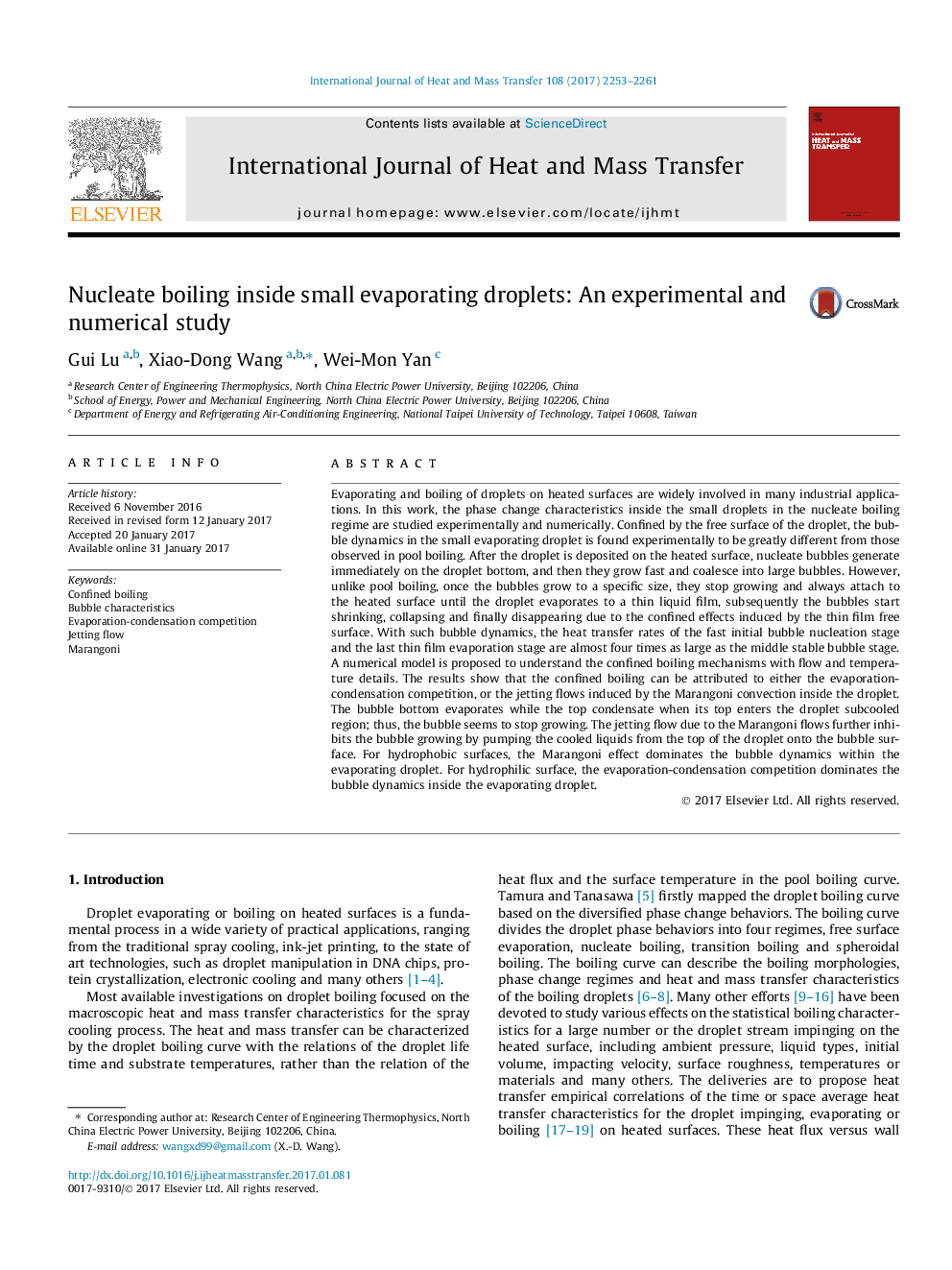| کد مقاله | کد نشریه | سال انتشار | مقاله انگلیسی | نسخه تمام متن |
|---|---|---|---|---|
| 4994443 | 1458033 | 2017 | 9 صفحه PDF | دانلود رایگان |
عنوان انگلیسی مقاله ISI
Nucleate boiling inside small evaporating droplets: An experimental and numerical study
ترجمه فارسی عنوان
جوشیدن هسته در داخل قطرات کوچک تبخیر: یک مطالعه تجربی و عددی
دانلود مقاله + سفارش ترجمه
دانلود مقاله ISI انگلیسی
رایگان برای ایرانیان
کلمات کلیدی
جوش محصور، خصوصیات حباب، رقابت تجمع تبخیری، جت جریان، مارانگونی،
ترجمه چکیده
تبخیر و جوش قطرات بر روی سطوح گرم به طور گسترده ای در بسیاری از کاربردهای صنعتی دخیل هستند. در این کار، ویژگی های تغییر فاز داخل قطرات کوچک در رژیم جوش هسته ای به صورت تجربی و عددی مورد مطالعه قرار می گیرند. بسته به سطح آزاد قطره، دینامیک حباب در قطره تبخیر کوچک به طور تجربی در نظر گرفته شده است که به شدت متفاوت از آنچه در گرمایش استخر دیده می شود. بعد از اینکه قطره در سطح گرم قرار می گیرد، حباب های هسته ای بلافاصله بر روی پایین قطره تولید می کنند و سپس سریع رشد می کنند و به حباب های بزرگ تقسیم می شوند. با این حال، بر خلاف جوشاندن استیل، هنگامی که حباب ها به یک اندازه خاص رشد می کنند، رشد آنها متوقف می شود و همیشه به سطح گرم متصل می شوند تا قطره به یک فیلم مایع ناپیوسته تبخیر می شود، بعدا حباب ها شروع به کاهش، فروپاشی و در نهایت با توجه به اثرات محدود می شوند ناشی از سطح آزاد فیلم نازک است. با چنین دینامیکی حباب، نرخ انتقال حرارت در مرحله ابتلای اولیه اولیه حباب و آخرین مرحله تبخیر فیلم نازک تقریبا چهار برابر بزرگتر از مرحله حباب باثبات است. یک مدل عددی برای درک مکانیسمهای جوش محدود با جزئیات جریان و دما پیشنهاد شده است. نتایج نشان می دهد که جوش محدود شده را می توان به رقابت با تجمع تبخیر و یا جریان های جابجایی ناشی از کنسانتره مارنگونی در داخل قطرات اشاره کرد. پایین حباب در حالی که میعانات بالا هنگامی که بالا آن وارد منطقه قطره قطره؛ بنابراین، حباب به نظر می رسد که رشد می کند. جریان جت به علت جریان مارانگونی بیشتر باعث افزایش رشد حباب شده توسط پمپاژ مایعات خنک از بالای قطره به سطح حباب می شود. برای سطوح هیدروفوب، اثر مارانگونی بر دینامیک حباب در داخل قطره تبخیر غالب است. برای سطح هیدروفولی، مساله تبخیر تبخیر غلظت پویایی حباب در داخل قطره تبخیر شده است.
موضوعات مرتبط
مهندسی و علوم پایه
مهندسی شیمی
جریان سیال و فرایندهای انتقال
چکیده انگلیسی
Evaporating and boiling of droplets on heated surfaces are widely involved in many industrial applications. In this work, the phase change characteristics inside the small droplets in the nucleate boiling regime are studied experimentally and numerically. Confined by the free surface of the droplet, the bubble dynamics in the small evaporating droplet is found experimentally to be greatly different from those observed in pool boiling. After the droplet is deposited on the heated surface, nucleate bubbles generate immediately on the droplet bottom, and then they grow fast and coalesce into large bubbles. However, unlike pool boiling, once the bubbles grow to a specific size, they stop growing and always attach to the heated surface until the droplet evaporates to a thin liquid film, subsequently the bubbles start shrinking, collapsing and finally disappearing due to the confined effects induced by the thin film free surface. With such bubble dynamics, the heat transfer rates of the fast initial bubble nucleation stage and the last thin film evaporation stage are almost four times as large as the middle stable bubble stage. A numerical model is proposed to understand the confined boiling mechanisms with flow and temperature details. The results show that the confined boiling can be attributed to either the evaporation-condensation competition, or the jetting flows induced by the Marangoni convection inside the droplet. The bubble bottom evaporates while the top condensate when its top enters the droplet subcooled region; thus, the bubble seems to stop growing. The jetting flow due to the Marangoni flows further inhibits the bubble growing by pumping the cooled liquids from the top of the droplet onto the bubble surface. For hydrophobic surfaces, the Marangoni effect dominates the bubble dynamics within the evaporating droplet. For hydrophilic surface, the evaporation-condensation competition dominates the bubble dynamics inside the evaporating droplet.
ناشر
Database: Elsevier - ScienceDirect (ساینس دایرکت)
Journal: International Journal of Heat and Mass Transfer - Volume 108, Part B, May 2017, Pages 2253-2261
Journal: International Journal of Heat and Mass Transfer - Volume 108, Part B, May 2017, Pages 2253-2261
نویسندگان
Gui Lu, Xiao-Dong Wang, Wei-Mon Yan,
